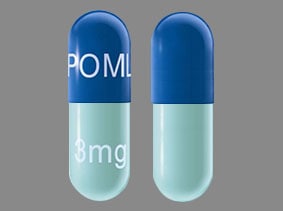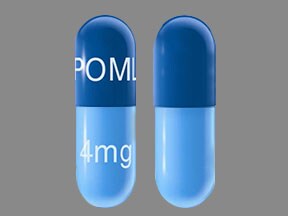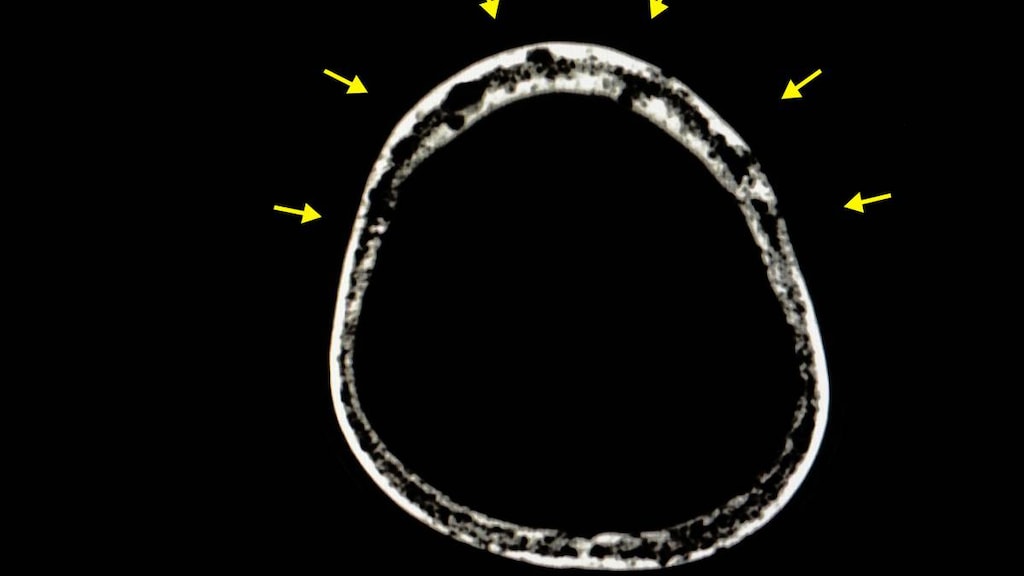What is Pomalyst?
Pomalyst is a prescription medicine used to treat adults with:
- Multiple myeloma. Pomalyst is taken along with the medicine dexamethasone, in people who:
- have received at least 2 prior medicines to treat multiple myeloma, including a type of medicine known as a proteasome inhibitor and lenalidomide, and
- their disease has become worse during treatment or within 60 days of finishing the last treatment
- AIDS-related Kaposi sarcoma (KS). Pomalyst is taken when highly active antiretroviral therapy (HAART) has not worked well enough or stopped working (failed)
- KS who do not have HIV infection (HIV negative).
It is not known if Pomalyst is safe and effective in children.
What is the most important information I should know about Pomalyst?
Before you begin taking Pomalyst, you must read and agree to all of the instructions in the Pomalyst REMS program. Before prescribing Pomalyst, your healthcare provider will explain the Pomalyst REMS program to you and have you sign the Patient-Physician Agreement Form.
Pomalyst can cause serious side effects including:
- Possible birth defects (deformed babies) or death of an unborn baby. Females who are pregnant or who plan to become pregnant must not take Pomalyst.
Pomalyst is similar to the medicine thalidomide (THALOMID). We know thalidomide can cause severe life-threatening birth defects. Pomalyst has not been tested in pregnant females. Pomalyst has harmed unborn animals in animal testing.
Females must not get pregnant:- For at least 4 weeks before starting Pomalyst
- While taking Pomalyst
- During any breaks (interruptions) in your treatment with Pomalyst
- For at least 4 weeks after stopping Pomalyst
- Will have pregnancy tests weekly for 4 weeks, then every 4 weeks if your menstrual cycle is regular, or every 2 weeks if your menstrual cycle is irregular.
If you miss your period or have unusual bleeding, you will need to have a pregnancy test and receive counseling. - Must agree to use two acceptable forms of birth control at the same time, for at least 4 weeks before, while taking, during any breaks (interruptions) in your treatment, and for at least 4 weeks after stopping Pomalyst.
- Talk with your healthcare provider to find out about options for acceptable forms of birth control that you may use to prevent pregnancy before, during, and after treatment with Pomalyst.
Healthcare providers and patients should report all cases of pregnancy to:- FDA MedWatch at 1-800-FDA-1088, and
- Celgene Corporation at 1-888-423-5436
Pomalyst can pass into human semen:- Males, including those who have had a vasectomy, must always use a latex or synthetic condom during any sexual contact with a pregnant female or a female that can become pregnant while taking Pomalyst, during any breaks (interruptions) in your treatment with Pomalyst, and for 4 weeks after stopping Pomalyst.
- Do not have unprotected sexual contact with a female who is or could become pregnant. Tell your healthcare provider if you do have unprotected sexual contact with a female who is or could become pregnant.
- Do not donate sperm while taking Pomalyst, during any breaks (interruptions) in your treatment, and for 4 weeks after stopping Pomalyst. If a female becomes pregnant with your sperm, the baby may be exposed to Pomalyst and may be born with birth defects.
- Blood clots in your arteries, veins, and lungs, heart attack, and stroke can happen if you take Pomalyst. Most people who take Pomalyst will also take a blood thinner medicine to help prevent blood clots.
Before taking Pomalyst, tell your healthcare provider:- If you have had a blood clot in the past
- If you have high blood pressure, smoke, or if you have been told you have a high level of fat in your blood (hyperlipidemia)
- About all the medicines you take. Certain other medicines can also increase your risk for blood clots
Call your healthcare provider or get medical help right away if you get any of the following during treatment with Pomalyst:- Signs or symptoms of a blood clot in the lung, arm, or leg may include: shortness of breath, chest pain, or arm or leg swelling
- Signs or symptoms of a heart attack may include: chest pain that may spread to the arms, neck, jaw, back, or stomach area (abdomen), feeling sweaty, shortness of breath, feeling sick or vomiting
- Signs or symptoms of stroke may include: sudden numbness or weakness, especially on one side of the body, severe headache or confusion, or problems with vision, speech, or balance.
Who should not take Pomalyst?
Do not take Pomalyst if you:
- are pregnant, plan to become pregnant, or become pregnant during treatment with Pomalyst. See "What is the most important information I should know about Pomalyst?"
- are allergic to pomalidomide or any of the ingredients in Pomalyst. See the end of this Medication Guide for a complete list of ingredients in Pomalyst.
What should I tell my healthcare provider before taking Pomalyst?
Before you take Pomalyst, tell your healthcare provider if you:
- smoke cigarettes. Pomalyst may not work as well in people who smoke
- have liver problems
- have kidney problems and are receiving hemodialysis treatment
- have any other medical conditions
- are breastfeeding. You should not breastfeed during treatment with Pomalyst. It is not known if Pomalyst passes into your breast milk and can harm your baby.
Tell your healthcare provider about all the medicines you take, including prescription and over-the-counter medicines, vitamins, and herbal supplements. Pomalyst and other medicines may affect each other, causing serious side effects. Talk with your healthcare provider before taking any new medicines.
Know the medicines you take. Keep a list of them to show your healthcare provider and pharmacist.
How should I take Pomalyst?
- Take Pomalyst exactly as prescribed and follow all the instructions of the Pomalyst REMS program.
- Swallow Pomalyst capsules whole with water 1 time a day. Do not break, chew, or open your capsules.
- Pomalyst may be taken with or without food.
- Take Pomalyst at about the same time each day.
- If you are on hemodialysis, take Pomalyst after hemodialysis, on hemodialysis days.
- Do not open the Pomalyst capsules or handle them any more than needed. If you touch a broken Pomalyst capsule or the medicine in the capsule, wash the area of your body right away with soap and water.
- If you miss a dose of Pomalyst and it has been less than 12 hours since your regular time, take it as soon as you remember. If it has been more than 12 hours, just skip your missed dose. Do not take 2 doses at the same time.
- If you take too much Pomalyst, call your healthcare provider right away.
What should I avoid while taking Pomalyst?
- See "What is the most important information I should know about Pomalyst?"
- Females: Do not get pregnant and do not breastfeed while taking Pomalyst.
- Males: Do not donate sperm.
- Do not share Pomalyst with other people. It may cause birth defects and other serious problems.
- Do not donate blood while you take Pomalyst, during any breaks (interruptions) in your treatment, and for 4 weeks after stopping Pomalyst. If someone who is pregnant gets your donated blood, her baby may be exposed to Pomalyst and may be born with birth defects.
- Pomalyst can cause dizziness and confusion. Avoid taking other medicines that may cause dizziness and confusion during treatment with Pomalyst. Avoid situations that require you to be alert until you know how Pomalyst affects you.
What are the possible side effects of Pomalyst?
Pomalyst can cause serious side effects, including:
- See "What is the most important information I should know about Pomalyst?"
- Low white blood cells (neutropenia), low platelets (thrombocytopenia), and low red blood cells (anemia) are common with Pomalyst, but can also be serious. You may need a blood transfusion or certain medicines if your blood counts drop too low. Your blood counts should be checked weekly for the first 8 weeks of treatment and monthly after that.
- Severe liver problems, including liver failure and death. Your healthcare provider should do blood tests to check your liver function during your treatment with Pomalyst. Tell your healthcare provider right away if you develop any of the following symptoms of liver problems:
- Yellowing of your skin or the white part of your eyes (jaundice)
- Dark or brown (tea-colored) urine
- Pain on the upper right side of your stomach area (abdomen)
- Bleeding or bruising more easily than normal
- Feeling very tired
- Severe allergic reactions and severe skin reactions can happen with Pomalyst and may cause death.
Call your healthcare provider if you develop any of the following signs or symptoms during treatment with Pomalyst:- a red, itchy, skin rash
- peeling of your skin or blisters
- severe itching
- fever
Get emergency medical help right away if you develop any of the following signs or symptoms during treatment with Pomalyst: - swelling of your lips, mouth, tongue, or throat
- trouble breathing or swallowing
- raised red areas on your skin (hives)
- a very fast heartbeat
- you feel dizzy or faint
- Dizziness and confusion. See "What should I avoid while taking Pomalyst?"
- Nerve damage. Stop taking Pomalyst and call your healthcare provider if you develop symptoms of nerve damage including: numbness, tingling, pain, burning sensation in your hands, legs, or feet.
- Risk of new cancers (malignancies). New cancers, including certain blood cancers (acute myelogenous leukemia or AML) have been seen in people who received Pomalyst. Talk with your healthcare provider about your risk of developing new cancers if you take Pomalyst.
- Tumor lysis syndrome (TLS). TLS is caused by the fast breakdown of cancer cells. TLS can cause kidney failure and the need for dialysis treatment, abnormal heart rhythm, seizure, and sometimes death. Your healthcare provider may do blood tests to check you for TLS.
Your healthcare provider may tell you to stop taking Pomalyst if you develop certain serious side effects during treatment.
The most common side effects of Pomalyst in people with Multiple Myeloma include:
- tiredness and weakness
- constipation
- nausea
- diarrhea
- shortness of breath
- upper respiratory tract infection
- back pain
- fever
The most common side effects of Pomalyst in people with KS include:
- tiredness
- diarrhea
- abnormal kidney function tests
- decreased phosphate and calcium in the blood
- rash. See "severe allergic reactions and severe skin reactions" above.
- nausea
- constipation
- increased blood sugar
- decreased albumin in the blood
These are not all the possible side effects of Pomalyst.
Call your doctor for medical advice about side effects. You may report side effects to the FDA at 1-800-FDA-1088.
Pomalyst Images
General information about the safe and effective use of Pomalyst
Medicines are sometimes prescribed for purposes other than those listed in a Medication Guide. Do not take Pomalyst for conditions for which it was not prescribed. Do not give Pomalyst to other people, even if they have the same symptoms you have. It may harm them and may cause birth defects.
If you would like more information, talk with your healthcare provider. You can ask your healthcare provider or pharmacist for information about Pomalyst that is written for health professionals.
For more information, call 1-888-423-5436 or go to www.CelgeneRiskManagement.com.
How should I store Pomalyst?
- Store Pomalyst at room temperature between 68°F to 77°F (20°C to 25°C).
- Return any unused Pomalyst to Celgene or your healthcare provider.
Keep Pomalyst and all medicines out of the reach of children.
What are the ingredients in Pomalyst?
Active ingredient: pomalidomide
Inactive ingredients: mannitol, pregelatinized starch, and sodium stearyl fumarate.
The 1-mg capsule shell contains gelatin, titanium dioxide, FD&C blue 2, yellow iron oxide, white ink, and black ink.
The 2-mg capsule shell contains gelatin, titanium dioxide, FD&C blue 2, yellow iron oxide, FD&C red 3, and white ink.
The 3-mg capsule shell contains gelatin, titanium dioxide, FD&C blue 2, yellow iron oxide, and white ink.
The 4-mg capsule shell contains gelatin, titanium dioxide, FD&C blue 1, FD&C blue 2, and white ink.




